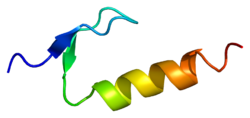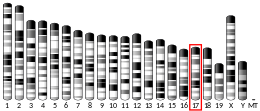DNA polymerase eta (Pol η), is a protein that in humans is encoded by the POLH gene.[5][6][7]
DNA polymerase eta is a eukaryotic DNA polymerase involved in the DNA repair by translesion synthesis. The gene encoding DNA polymerase eta is POLH, also known as XPV, because loss of this gene results in the disease xeroderma pigmentosum. Polymerase eta is particularly important for allowing accurate translesion synthesis of DNA damage resulting from ultraviolet radiation or UV.
Function
editThis gene encodes a member of the Y family of specialized DNA polymerases. It copies undamaged DNA with a lower fidelity than other DNA-directed polymerases. However, it accurately replicates UV-damaged DNA; when thymine dimers are present, this polymerase inserts the complementary nucleotides in the newly synthesized DNA, thereby bypassing the lesion and suppressing the mutagenic effect of UV-induced DNA damage. This polymerase is thought to be involved in hypermutation during immunoglobulin class switch recombination.[5]
Bypass of 8-oxoguanine
editDuring DNA replication of the Saccharomyces cerevisiae chromosome, the oxidative DNA damage 8-oxoguanine triggers a switch to translesion synthesis by DNA polymerase eta.[8] This polymerase replicates 8-oxoguanine with an accuracy (insertion of a cytosine opposite the 8-oxoguanine) of approximately 94%. Replication of 8-oxoguanine in the absence of DNA polymerase eta is less than 40%.
Clinical significance
editMutations in this gene result in XPV, a variant type of xeroderma pigmentosum, characterized by sun sensitivity, elevated incidence of skin cancer, and at the cellular level, by delayed replication and hypermutability after UV-irradiation[9][10]
Interactions
editReferences
edit- ^ a b c GRCh38: Ensembl release 89: ENSG00000170734 – Ensembl, May 2017
- ^ a b c GRCm38: Ensembl release 89: ENSMUSG00000023953 – Ensembl, May 2017
- ^ "Human PubMed Reference:". National Center for Biotechnology Information, U.S. National Library of Medicine.
- ^ "Mouse PubMed Reference:". National Center for Biotechnology Information, U.S. National Library of Medicine.
- ^ a b "Entrez Gene: POLH polymerase (DNA directed), eta".
- ^ Masutani C, Kusumoto R, Yamada A, Dohmae N, Yokoi M, Yuasa M, Araki M, Iwai S, Takio K, Hanaoka F (June 1999). "The XPV (xeroderma pigmentosum variant) gene encodes human DNA polymerase eta". Nature. 399 (6737): 700–4. Bibcode:1999Natur.399..700M. doi:10.1038/21447. PMID 10385124. S2CID 4429698.
- ^ Johnson RE, Kondratick CM, Prakash S, Prakash L (July 1999). "hRAD30 mutations in the variant form of xeroderma pigmentosum". Science. 285 (5425): 263–5. doi:10.1126/science.285.5425.263. PMID 10398605.
- ^ Rodriguez GP, Song JB, Crouse GF (2013). "In vivo bypass of 8-oxodG". PLOS Genet. 9 (8): e1003682. doi:10.1371/journal.pgen.1003682. PMC 3731214. PMID 23935538.
- ^ Stary A, Sarasin A (September 2002). "Molecular mechanisms of UV-induced mutations as revealed by the study of DNA polymerase eta in human cells". Res. Microbiol. 153 (7): 441–5. doi:10.1016/S0923-2508(02)01343-8. PMID 12405351.
- ^ Cruet-Hennequart S, Gallagher K, Sokòl AM, Villalan S, Prendergast AM, Carty MP (2010). "DNA Polymerase η, a Key Protein in Translesion Synthesis in Human Cells". Genome Stability and Human Diseases. Subcellular Biochemistry. Vol. 50. pp. 189–209. doi:10.1007/978-90-481-3471-7_10. ISBN 978-90-481-3470-0. PMID 20012583.
- ^ Haracska L, Johnson RE, Unk I, Phillips B, Hurwitz J, Prakash L, Prakash S (November 2001). "Physical and functional interactions of human DNA polymerase eta with PCNA". Mol. Cell. Biol. 21 (21): 7199–206. doi:10.1128/MCB.21.21.7199-7206.2001. PMC 99895. PMID 11585903.
Further reading
edit- Plachta M, Halas, McIntyre J, Sledziewska-Gojska E (2015). "The steady-state level and stability of TLS polymerase eta are cellcycle dependent in the yeast S. cerevisiae". DNA Repair. 29: 147–153. doi:10.1016/j.dnarep.2015.02.015. PMID 25766643.
- Skoneczna A, McIn Atyre J, Skoneczny M, Policinska Z, Sledziewska-Gojska E (2007). "Polymerase eta is a short-lived, proteasomally degraded protein that is temporarily stabilized following UV irradiation in Saccharomyces cerevisiae". J. Mol. Biol. 366 (4): 1074–86. doi:10.1016/j.jmb.2006.11.093. PMID 17198712.
- Masutani C, Kusumoto R, Yamada A, Dohmae N, Yokoi M, Yuasa M, Araki M, Iwai S, Takio K, Hanaoka F (1999). "The XPV (xeroderma pigmentosum variant) gene encodes human DNA polymerase eta". Nature. 399 (6737): 700–4. Bibcode:1999Natur.399..700M. doi:10.1038/21447. PMID 10385124. S2CID 4429698.
- Johnson RE, Kondratick CM, Prakash S, Prakash L (1999). "hRAD30 mutations in the variant form of xeroderma pigmentosum". Science. 285 (5425): 263–5. doi:10.1126/science.285.5425.263. PMID 10398605.
- Masutani C, Kusumoto R, Iwai S, Hanaoka F (2000). "Mechanisms of accurate translesion synthesis by human DNA polymerase eta". EMBO J. 19 (12): 3100–9. doi:10.1093/emboj/19.12.3100. PMC 203367. PMID 10856253.
- Yamada A, Masutani C, Iwai S, Hanaoka F (2000). "Complementation of defective translesion synthesis and UV light sensitivity in xeroderma pigmentosum variant cells by human and mouse DNA polymerase eta". Nucleic Acids Res. 28 (13): 2473–80. doi:10.1093/nar/28.13.2473. PMC 102698. PMID 10871396.
- Yuasa M, Masutani C, Eki T, Hanaoka F (2000). "Genomic structure, chromosomal localization and identification of mutations in the xeroderma pigmentosum variant (XPV) gene". Oncogene. 19 (41): 4721–8. doi:10.1038/sj.onc.1203842. PMID 11032022.
- Itoh T, Linn S, Kamide R, Tokushige H, Katori N, Hosaka Y, Yamaizumi M (2000). "Xeroderma pigmentosum variant heterozygotes show reduced levels of recovery of replicative DNA synthesis in the presence of caffeine after ultraviolet irradiation". J. Invest. Dermatol. 115 (6): 981–5. doi:10.1046/j.1523-1747.2000.00154.x. PMID 11121129.
- Zeng X, Winter DB, Kasmer C, Kraemer KH, Lehmann AR, Gearhart PJ (2001). "DNA polymerase eta is an A-T mutator in somatic hypermutation of immunoglobulin variable genes". Nat. Immunol. 2 (6): 537–41. doi:10.1038/88740. PMID 11376341. S2CID 6213513.
- Matsuda T, Bebenek K, Masutani C, Rogozin IB, Hanaoka F, Kunkel TA (2001). "Error rate and specificity of human and murine DNA polymerase eta". J. Mol. Biol. 312 (2): 335–46. doi:10.1006/jmbi.2001.4937. PMID 11554790.
- Haracska L, Johnson RE, Unk I, Phillips B, Hurwitz J, Prakash L, Prakash S (2001). "Physical and functional interactions of human DNA polymerase eta with PCNA". Mol. Cell. Biol. 21 (21): 7199–206. doi:10.1128/MCB.21.21.7199-7206.2001. PMC 99895. PMID 11585903.
- Glick E, Vigna KL, Loeb LA (2001). "Mutations in human DNA polymerase eta motif II alter bypass of DNA lesions". EMBO J. 20 (24): 7303–12. doi:10.1093/emboj/20.24.7303. PMC 125802. PMID 11743006.
- Limoli CL, Giedzinski E, Bonner WM, Cleaver JE (2002). "UV-induced replication arrest in the xeroderma pigmentosum variant leads to DNA double-strand breaks, gamma -H2AX formation, and Mre11 relocalization". Proc. Natl. Acad. Sci. U.S.A. 99 (1): 233–8. Bibcode:2002PNAS...99..233L. doi:10.1073/pnas.231611798. PMC 117544. PMID 11756691.
- Broughton BC, Cordonnier A, Kleijer WJ, Jaspers NG, Fawcett H, Raams A, Garritsen VH, Stary A, Avril MF, Boudsocq F, Masutani C, Hanaoka F, Fuchs RP, Sarasin A, Lehmann AR (2002). "Molecular analysis of mutations in DNA polymerase eta in xeroderma pigmentosum-variant patients". Proc. Natl. Acad. Sci. U.S.A. 99 (2): 815–20. Bibcode:2002PNAS...99..815B. doi:10.1073/pnas.022473899. PMC 117388. PMID 11773631.
- Chiapperino D, Kroth H, Kramarczuk IH, Sayer JM, Masutani C, Hanaoka F, Jerina DM, Cheh AM (2002). "Preferential misincorporation of purine nucleotides by human DNA polymerase eta opposite benzo[a]pyrene 7,8-diol 9,10-epoxide deoxyguanosine adducts". J. Biol. Chem. 277 (14): 11765–71. doi:10.1074/jbc.M112139200. PMID 11821420.
- Kusumoto R, Masutani C, Iwai S, Hanaoka F (2002). "Translesion synthesis by human DNA polymerase eta across thymine glycol lesions". Biochemistry. 41 (19): 6090–9. doi:10.1021/bi025549k. PMID 11994004.
- Yavuz S, Yavuz AS, Kraemer KH, Lipsky PE (2002). "The role of polymerase eta in somatic hypermutation determined by analysis of mutations in a patient with xeroderma pigmentosum variant". J. Immunol. 169 (7): 3825–30. doi:10.4049/jimmunol.169.7.3825. PMID 12244178.
- Kannouche P, Fernández de Henestrosa AR, Coull B, Vidal AE, Gray C, Zicha D, Woodgate R, Lehmann AR (2002). "Localization of DNA polymerases eta and iota to the replication machinery is tightly co-ordinated in human cells". EMBO J. 21 (22): 6246–56. doi:10.1093/emboj/cdf618. PMC 137208. PMID 12426396.
- Zheng H, Wang X, Warren AJ, Legerski RJ, Nairn RS, Hamilton JW, Li L (2003). "Nucleotide excision repair- and polymerase eta-mediated error-prone removal of mitomycin C interstrand cross-links". Mol. Cell. Biol. 23 (2): 754–61. doi:10.1128/MCB.23.2.754-761.2003. PMC 151552. PMID 12509472.
- Yang IY, Miller H, Wang Z, Frank EG, Ohmori H, Hanaoka F, Moriya M (2003). "Mammalian translesion DNA synthesis across an acrolein-derived deoxyguanosine adduct. Participation of DNA polymerase eta in error-prone synthesis in human cells". J. Biol. Chem. 278 (16): 13989–94. doi:10.1074/jbc.M212535200. PMID 12584190.
- Kannouche P, Fernández de Henestrosa AR, Coull B, Vidal AE, Gray C, Zicha D, Woodgate R, Lehmann AR (2003). "Localization of DNA polymerases eta and iota to the replication machinery is tightly co-ordinated in human cells". EMBO J. 22 (5): 1223–33. doi:10.1093/emboj/cdf618. PMC 150329. PMID 12606586.
External links
editThis article incorporates text from the United States National Library of Medicine, which is in the public domain.





